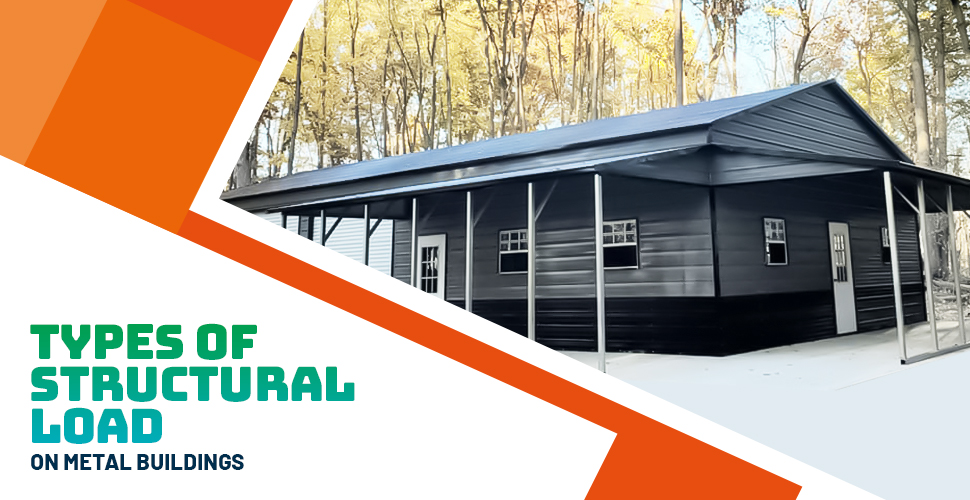
- September 28, 2022
- Metal Buildings
- Carports Advisor
Types of Structural Load on Metal Buildings
Considering structural loads is crucial for the stability and lifespan of steel buildings. It is an essential factor you should consider before buying a metal building. You must know about structural loads if you own a metal building or planning for one.
Building codes are also comprised of load factors that are crucial for the safety of the steel building. In layman’s terms, structural load can be explained as the stress imposed by any object on the structure. A force, acceleration, or deformation could be applied to a facility.
Structural load beyond the capacity of the metal building can cause stress, displacement, or deformation in the structure. It is a possible threat to establishments that should be considered in the initial stages of construction planning to prevent hazards in the future. Knowing the types of structural load and factors that influence the load response can help you design a robust structure that lasts for decades.
Types of Loads on Metal Buildings
All types of structural load are a potential risk for the prefab steel structure. By assessing the location of the prefab building, you can find types of loads that are specifically crucial for your establishment. Considering the following load types can help you decide on safety measures for the building you are going for.
Dead Loads
Dead loads are also known as static or permanent load types; they create static force, which is relatively constant. Mostly self-weight or a load of permanent structural elements is considered in the dead load category. It can also include accessories added to the metal building for various purposes.
These load types are planned based on the structural layout of the metal building, considering all safety measures. It is essential to work with a proper plan or strategy to apply such static or dead load on the structure. It can help you maintain the integrity of the facility and avoid significant damage.
Live Loads
Live loads are slightly different from dead loads. The period for which live loads are applied to the structure varies according to its purpose. Mainly, all transitory and temporary loads fall in this category of loads.
Any load configured to the structure is temporarily considered a live load. The force imposed by any live load is not constant; it may vary over time. It mainly includes a load of people, furniture, vehicles, and also the pressure imposed by air on an elevation.
The period these loads are applied to the structure depends on various factors, including weather, specific purpose, or requirement. Live loads also include snow accumulated on the facility’s top. It isn’t easy to find the magnitude of live loads accurately. You can prevent any distortion or damage to the structure by preparing it in such a way.
Environmental Loads
Pressure or force caused by environmental factors is referred to as environmental loads. Environmental loads mainly comprise weather conditions like snowfall, strong winds, or other natural disasters.
Building laws designed by the local authority are based on periodic Assessments of all environmental factors.
Local building laws guide the individual, metal structure designer, or engineer to design metal structures. All the measures considered in the building laws comply with the minimum requirements to ensure safety and security.
Miscellaneous Loads
Loads that do not fall into the above three categories, dead loads, live loads, and environmental loads, are known as miscellaneous loads. For example, explosion, fire, and vibrations are the most common types of miscellaneous loads.
These loads are severe risk factors that must be considered for steel buildings, especially for the facilities like a metal carport to make required altercations. A robust and well-designed structure can help you prevent the fatal impact of these loads.
Load Combinations
From all types of structural loads, dead loads are constant in metal buildings in the form of self-weight. Buildings like vertical roof metal carports can endure multiple loads simultaneously. These facilities are designed to bear additional pressure or strain. Along with dead loads, certified steel buildings also can handle live loads or environmental loads without significant damage or distortion.
Influential Factors for Load Response
If you are planning for a prefab steel carport, you must learn about the factors influencing load response. Considering the following factors will help you design a structure capable of handling intense loads without getting affected.
Load Distribution
Before planning or installing a metal carport structure, consider load distribution is the most important. It should be uniform across the entire facility. Uniform distribution of load or pressure will prevent a load spike on specific points that can cause severe damage to the metal structure.
Uniform load distribution is also crucial to ensure the integrity and stability of the metal building. It can enhance the lifespan of the structure.
E-Value
Elasticity is the following measure that must be considered for the metal facility. Elasticity can be explained as the ability of the structure to retain its shape. Finding the correct load ratio is crucial to understanding the potential risk of deformation. Buildings with higher E-value can offer better safety than other structures with low E-value.
Strength and Deflection
Strength and deflection are two crucial measures that must be evaluated for steel structures. The deflection of the building can be calculated using live load.
In addition, the structure’s strength can be assessed using both live and dead loads. Both of these factors are crucial to ensure the stability of a steel building.
Find a Secure and Stable Building
If you don’t want to go into the bulky calculations, you can simply contact us at ☎️ (336)-914-1654 to get a better idea about metal carports and different types of structural load. We at Carports Advisor are always ready to offer you with best metal building at competitive pricing.
